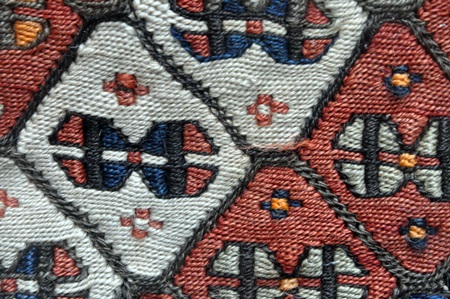Hi Marla,
As no one has called my bluff, I might as well do it
myself. I have been looking around some more at these words.
I now
think that tül is the French tulle, a light netted fabric produced in
Tulle. Turkish has many loan words from French, so it's not too
farfetched. Unlikely that Tulu would derive from that, as the character of
the structure is not the same.
I have seen assertions that tüylü,
meaning 'hairy', becomes tulu in English. Possible, I
suppose.
Anyway, as recompense for leading us all astray, I present
a piece from the Selcuk University site, in their Arts and Culture guide
http://www.selcuk.edu.tr/kultur/kasim/ which I translate
as well as I am able, being open to correction from native, or just
better, Turkish speakers. It doesn't deal with the etymology of Tulu but
is seems pretty clear on the kinds of materials in use. The author, melek
hidayetoğlu, could presumably be contacted for sources
etc.
Tülü
In weaving rugs on looms, a large majority of
mats using the natural colours of Angora goat’s wool and sheep’s wool,
with warp and weft yarn of wool, pile(knot) wool generally called ‘filik’
from the Angora, with knot rows sparsely spaced, with a long pile height,
soft, and with coarse weave, are called ‘tülü’.
In Konya,
Karapınar, Obruk, Ankara, Yozgat, Kırşehir, Sivas, Malatya, Van, Mut and
Adıyaman, as well as being popular in Central Anatolia, a good quantity of
weavings are produced, of those we traditionally weave, and are popular.
And, in Anatolia, names like geve, hopan, tülüce, filikli are given to
‘tülü’s.
In making ‘tülü’s, usually natural colours are used.
Sometimes, they are dyed with a variety of colours; yarns hand made of
wool, Angora and camel are used. The ‘tülü’s combed, spun and dyed weft
threads, and the warp and pile yarn, are created. The wool yarn used in
weaving the ‘tülü’ is produced from local people’s sheep, and is handmade
with the shorn wool. The ‘tülü’ rug is woven by three different
techniques; the knotted ‘tülü’, the ‘yamçı tülü’ and the ‘çekki’
tülü.
The ‘yamçı tülü’ is predominantly made preserving the
original length of the hair of the Angora, without combing. And the ‘yamçı
tülü’ knot yarn for use has the appearance of sheep’s fleece. Taking a
handful of Angora, and wefting(?) in the Turkish knot style over two
warps, the knot rows are created(?). Between each (knot row?)15 and 30
wefts are shot. Weft and warp yarns are wool. Also, for ‘yamçı tülü’
mostly white, red, green or blue dyes are used. Generally, a single
colour, with no decoration, is woven, created with vertical lines placed
haphazard and worked up with square designs. It is the young girls’ dowry
rug and takes its place at their side as a protection against the cold,
its purpose being as a hanging on the house walls. In other circumstances,
in the past, it covered over the backs and tails of riding
horses.
Knotted ‘tülü’s are woven working up the rug with
combed and spun yarn, wool and Angora, using the Turkish knot technique.
As the knife is not used too much on the rug, the knot yarn is left in
place and the pile varies from 1 to 6 cm in length. After every knot row,
2 to 5 rows of weft yarn are passed over. In this way, ‘tülü’s are created
which are called for in every part of the house; being used as beds,
dowry, chair covers, couch covers.
The ‘çekki tülü’ differs
most from other ‘tülü’s in being without knots. Its loops are left formed
by the passing of the weft yarn, pulling it with the help of a crochet
hook, between the warps. The pile is 2 to 4 cm long and after every 2 to 5
rows, the weft yarn row being bypassed, it is tightened(?). ‘Tülü’s woven
using this technique differ in appearance from handmade knotted ones on
account of the closed pile ends.
The ‘çekki tülü’ is woven for use
as chair covers, bedspreads, dowry rugs primarily, in natural Angora
colours and without decoration. As the weaving technique is more
difficult, they are produced in smaller quantities.
Although the
‘tülü’ displays a similarity to other traditional weavings, at the same
time it has its own special character of design. It is hard to find ones
with the same design. People’s creativity perpetuates the talents and
remnants of tradition. ‘Tülü’ are charged with quite a few functions
abroad. They are used as spreads, bedcovers, chair covers, prayer rugs,
hung on walls as heat insulation and covers to protect horses and camels
from the cold.
melek hidayetoğlu














